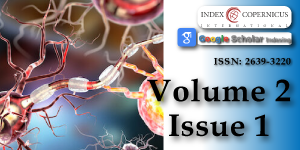Brain and immune system: KURU disease a toxicological process?
Main Article Content
Abstract
Starting from observation of pathogenesis of KURU disease we try to investigate the immunologic role played by central nervous systems. A deeply knowledge in the transmission model of this pathology can be an imaging/diagnostic tool to Verify the progression of this prion molecule from gastro intestinal systems to the brain. (After cannibalistic behavior). The prions can be considered a sort of trace ant in KURU to monitoring this process and immune- brain relationship. Interesting information can be obtained useful to produce new pharmacological strategies in some other degenerative brain disease involving innate immune system activation.
Article Details
Copyright (c) 2018 Luisetto M, et al.

This work is licensed under a Creative Commons Attribution 4.0 International License.
Luisetto M. Brain response in some systemic immune condition-Toxicological aspects. Insights Clin Cell Immunol. 2017; 1: 005-008. Ref.: https://goo.gl/Rp9s2K
Shirley Lindenbaum. Understanding kuru: the contribution of anthropology and medicine. Philos Trans R Soc Lond B Biol Sci. 2008; 363: 3715-3720. Ref.: https://goo.gl/LjygFe
Haïk S, Brandel JP. Infectious prion diseases in humans: cannibalism, iatrogenicity and zoonoses. Infect Genet Evol. 2014; 26: 303-312. Ref.: https://goo.gl/w2c1y5
D Carleton Gajdusek. Philos Kuru and its contribution to medicine. Trans R Soc Lond B Biol Sci. 2008; 363: 3697-3700. Ref.: https://goo.gl/RRWb73
Barry M. Bradford and Neil A. Mabbott. Prion Disease and the Innate Immune System. Viruses. 2012; 4: 3389-3419. Ref.: https://goo.gl/kjNGgd
Patrik Brundin, Jiyan Ma and Jeffrey H Kordower. How strong is the evidence that Parkinson’s disease is a prion disorder? Curr Opin Neurol. 2016; 29: 459-466. Ref: https://goo.gl/MqEBuF
Thomas Korn, Axel Kallies. T cell responses in the central nervous system. Nature Reviews Immunology. 17: 179-194. Ref.: https://goo.gl/LJTz2F
Iannacone M, Moseman EA, Tonti E, Bosurgi L, Junt T, et al. Subcapsular sinus macrophages prevent CNS invasion on peripheral infection with a neurotropic virus. Nature. 2010; 465:1079-1083. Ref.: https://goo.gl/wPRjQi
Ironside JW, Ritchie DL, Head MW2. Prion diseases. Handb Clin Neurol. 2017; 145: 393-403.
Iwasaki Y, Saito Y, Aiba I, Kobayashi A, Mimuro M, et al. An autopsied case of MV2K + C-type sporadic Creutzfeldt-Jakob disease presenting with widespread cerebral cortical involvement and Kuru plaques. Neuropathology. 2017; 37: 241-248.Ref.: https://goo.gl/uUaFfr
Rayman JB, Kandel ER. Functional Prions in the Brain. Cold Spring Harb Perspect Biol. 2017; 3: 9. Ref.: https://goo.gl/8RBUQJ
David C. Wraith and Lindsay B. Nicholson. The adaptive immune system in diseases of the central nervous system. J Clin Invest. 2012; 122: 1172-1179. Ref.: https://goo.gl/gfeiHo
Wendeln AC, Degenhardt K, Kaurani L, Gertig M, Ulas T, et al. Innate immune memory in the brain shapes neurological disease hallmarks. Nature. 2018; 556: 332-338. Ref.: https://goo.gl/fCZtKc
Robert Dantzer. Neuroimmune Interactions: From the Brain to the Immune System and Vice Versa. 2017. Ref.: https://goo.gl/WgT9Gn
Weil RS, Lashley TL, Bras J, Schrag AE, Schott JM. Current concepts and controversies in the pathogenesis of Parkinson’s disease dementia and Dementia with Lewy Bodies. F1000Res. 2017; 6: 1604. Ref.: https://goo.gl/nyTDYn
Gail Chan, Charles C White, Phoebe A Winn, Maria Cimpean, Joseph M Replogle, et al. CD33 modulates TREM2: convergence of Alzheimer loci. Nature Neuroscience. 2015; 18: 1556-1558. Ref.: https://goo.gl/nnNw3o
Paul S, Planque S, Nishiyama Y. Immunological origin and functional properties of catalytic autoantibodies to amyloid beta peptide. J Clin Immunol. 2010; 1: S43-S49. Ref.: https://goo.gl/XWMnfz
Holmes BB, Diamond MI. Prion-like properties of Tau protein: the importance of extracellular Tau as a therapeutic target. J Biol Chem. 2014; 289: 19855-19861. Ref.: https://goo.gl/fnZyzH
Bhaskar K, Konerth M, Kokiko-Cochran ON, Cardona A, Ransohoff RM, et al. Regulation of Tau Pathology by the Microglial Fractalkine Receptor. Neuron. 2010; 68: 19-31. Ref.: https://goo.gl/eZyGR3
Heppner FL, Ransohoff RM, Becher B. Immune attack: the role of inflammation in Alzheimer disease. Nat Rev Neurosci. 2015; 16: 358-372. Ref.: https://goo.gl/Jm17rH
Heneka MT, Golenbock DT, Latz E. Innate immunity in Alzheimer's disease. Nat Immunol. 2015; 16: 229-236. Ref.: https://goo.gl/dbfgbk
Luisetto M. Intra- Local Toxicology Aspect Time Related in Some Pathologic Conditions. Open Acc J of Toxicol. 2017; 2. Ref.: https://goo.gl/nzZB6b
Götz J, Ittner A, Ittner LM. Tau-targeted treatment strategies in Alzheimer's disease. Br J Pharmacol. 2012; 165: 1246-1259. Ref.: https://goo.gl/s1xMkE





